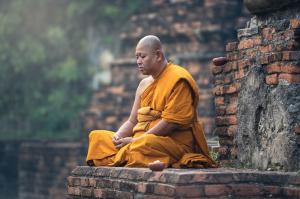 Although Eastern spiritual concepts began to make their way into Western culture more than half a century ago, in recent decades it has come out of the yoga studios and entered the mainstream culture. Attention paid to meditation and “mindfulness” practices occurs with increasing frequency in medical, academic, business, and popular media.
Although Eastern spiritual concepts began to make their way into Western culture more than half a century ago, in recent decades it has come out of the yoga studios and entered the mainstream culture. Attention paid to meditation and “mindfulness” practices occurs with increasing frequency in medical, academic, business, and popular media.
As often happens with any novel trend, it tends to be faddishly applied first as a new spin on existing culture. Accordingly, we see meditation and mindfulness promoted as a means for stress management or performance improvement or a means to gain competitive edge.
Yet fads tend to die out quickly, and particularly so for those that require substantial dedication and unfold over a span of years or decades. Meditation is generally thought of as a life-long practice with no particular “success” criterion. So, what is it really about, why do it, and why should it take so long?
I once took a class from a meditation teacher who for a time had served as translator for the Dali Lama. This teacher had a background in mathematics and the sciences, so at one point His Holiness asked “Considering your background, might you be able to find a way to accelerate the meditation process so that does not take 20-30 years for some practitioners to become sufficiently adept?”
I found that rather eye-opening, since most ancient philosophical and religious traditions tend to become “set in stone” — and any questioning or deviation is often looked upon as heresy. Yet, despite the various schools of practice, the millennia of tradition, and the millions of practitioners throughout history, might there be something we are missing in regard to meditation practice? Or something that might be improved in some way? The Dali Lama’s question has stuck with me all of the years since.
When any activity leads to an outcome, it is common to want to identify the procedures, the steps along the way, that move one from point A to point B. While meditation may not be a goal-oriented practice in the same way as most other human activity, it does have a general purpose or orientation toward abstract outcomes like self-awareness, enlightenment, equanimity, compassion, freedom from illusion, and the like. Yet these seem to occur randomly, sporadically, unpredictably — and at different rates for different people. For some, they may never occur at all.
Perhaps this is because some key factor or insight is lacking, therefore the mind must stumble upon it through some sort of random, fortuitous accident — one that may take decades to arrive, if at all. Were this the case, the current practice of zazen (sitting meditation, with eyes closed and the body and mind kept still) makes complete sense. The general intent of such practice is to remain alert and aware, but to be free from all distraction — external sights, sounds, and sensations – and in particular, internal thoughts, feelings, fantasies, and other mental excursions. To the degree that one succeeds at this, it is thought to be the optimal condition for samadhi/ awakening/ enlightenment to randomly occur. Yet again, it may take years.
The above strikes me somewhat like a blindfolded man swinging at a golf ball. He might occasionally hit the ball, and after 20 or 30 years of trying, he might even hit a hole-in-one, but clearly he would be far more effective if he gained vision in regard to what he is attempting. I wonder if something similar might not apply in regard to meditation practice and the quest for enlightenment?
When reduced to a single term, the purpose of meditation is often described as “enlightenment”. Yet even that term may mean different things to different people — ranging from greater self-awareness to achieving virtual divinity.
A surprisingly simple, practical definition that I like was offered by Buddhist meditation teacher Gil Fronsdahl (Insight Meditation Center, Redwood City): “Enlightenment is simply the awareness that there is a difference between reality and your story about reality.”
“Story” in this instance does not imply something false or improper. After nine or so months in a relatively dark, quiet, peaceful womb, each of us is born into a world of “blooming, buzzing, confusion” (William James) — whereafter we must make sense of things by creating a map of the world — a “story” about what-means-what and who-is-who, and how it all works together, so that we can have a reasonably functional life. Yet every person’s experience is unique. Accordingly, every person’s story about the world and how it works, is also unique.
Most of the time, our stories overlap well enough that we can function together as a society. Yet virtually every human conflict arises when discrepancies occur between one person or group’s story versus that of another. (An NGO I used to volunteer with maintained that “An enemy is merely someone whose story you have not heard.”)
In addition, our perceptual abilities are limited, and we rarely have all of the relevant information, so our stories, our maps of the world, will always be somewhat incomplete and to varying degrees, inaccurate. Much of the practice of psychotherapy is directed toward helping people revisit their conclusions about themselves and their experiences of the world, and then ideally retell the story in a more accurate and constructive way.
Extreme Meditation
Like many other people, I’ve been engaged with a decades-long, on-again, off-again practice of meditation — often with the sense that I am somehow not doing it “right”. In retrospect, this is probably because I did not have a clear sense of the process I’m engaged in, nor its goals. Yes, I pursue abstract goals like equanimity, non-attachment, enlightenment, and such, but what does this practically mean? And how or why would my current practice facilitate this?
When one is not clear about what one is doing, sometimes the interim strategy is simply to do more of it. (It’s like money for example. If you don’t know how much you actually need to be happy, the default answer is always “more”.)
It is not unusual for some meditators to regularly spend a month or more on silent meditation retreats. I once met a meditation teacher who in youth traveled through Burma and Thailand and at one point, for 18 months, spent the majority of the day in solitary sitting meditation.
This is not to disparage anyone else’s experience. We all are laboring to find our own way through life — and substantially without a roadmap. It is not for one to judge another’s experience. (The above mentioned traveller stated that his 18 months on the cushion was one of his most valuable life experiences.)
Yet there seems a predisposition in spiritual practice to turn it into some form of asceticism. In the collective psyche, we tend to place a divide between the mortal/physical realm and the spiritual. In order to more fully embrace the latter, some believe they must deny or disparage the former, sometimes demonstrated through degrees of self-neglect or even abuse. Accordingly, this may be reflected in some of the more “heroic” periods of meditative withdrawal from daily life.
To be clear, meditation is a valuable practice for developing the “muscle” of putting a little space between stimulus and reflex reaction in daily life — thus increasing conscious awareness of and appreciation for the world one lives in. Like physical exercise, it does require some amount of commitment and regular practice. Moreover, each person is unique, so no one can judge for another the point at which freedom from distraction becomes an ascetic shunning of mortal existence.
Instant Enlightenment
Hopefully it is not due to personal laziness, but I have become quite enamored with the notion of “instant” enlightenment. Perhaps it need not take decades of waiting silently on a cushion. If one accepts the simple definition of enlightenment as described above (ultimate realty versus personal story about reality), that shift in awareness can happen literally in an instant.
The layperson’s conception of enlightenment is similar to the lay conception of a heavenly kingdom: one passes through The Gate and then dwells there forever after. It is as though the incredible gift of earthly life is merely an annoyance or a test that we must put up with before being granted all of the goodies.
However, if we consider life not as an ordeal simply to be endured but rather as a gift of experience and opportunity – even one with purpose – then we cannot remain permanently in the enlightenment state (or as a former pastor once observed: “so heavenly minded that we are of no earthly use”).
Rather, enlightenment is probably a state that we regularly visit for restoration, recharge, and reorientation — a reconnection with that original source from which we emerged. Then we must return to daily life – our world of experience — in order to manifest the best of which we are capable.
In this light, the goal of meditation practice then is not to reach Heaven or Nirvana and stay there, but to develop an easeful skill at traveling between the realms — perhaps many, many times per day. Simply stated, perhaps the goal of enlightenment is not measured by quantity or duration but by frequency — not by how long one can stay apart from the world but by how successfully and frequently one can bridge these realms — the physical and the spiritual, the mortal and the divine. In the one, we remember our source. In the other, we live it.
Perhaps this is how we ultimately arrive at the long-sought marriage of Heaven and Earth.












